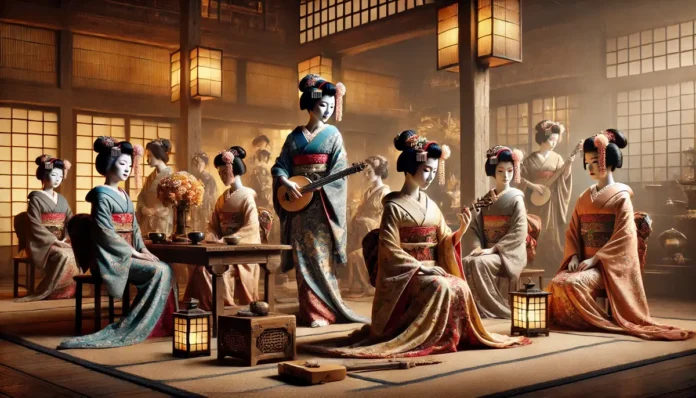The history of Geisha is a fascinating journey through Japan’s rich cultural tapestry.
As symbols of elegance and artistry, Geisha have represented the pinnacle of traditional Japanese entertainment for centuries.
But where did this unique tradition originate, and how has it evolved over time?
This article will explore the origins, roles, and development of Geisha within Japanese society.
The History of Geisha
Definition: Who Are Geisha?
The term Geisha translates to “art person” or “artist” in Japanese. Geisha are highly skilled entertainers who master traditional arts such as music, dance, and conversation.
Their purpose is not only to entertain but also to embody the grace and sophistication of Japanese culture.
Key traits of Geisha include:
- Mastery of instruments like the shamisen (a three-stringed lute).
- Proficiency in traditional dances such as the elegant Mai.
- Expertise in conducting a tea ceremony, a hallmark of Japanese hospitality.
Their role in society extends beyond mere entertainment, serving as cultural ambassadors who preserve and celebrate Japan’s artistic heritage.
Learnmore: What is a Geisha in Japan: Discover the Fascinating Geisha and Geiko Traditions
The Origins of Geisha
The history of Geisha is a fascinating evolution rooted in Japan’s cultural and artistic heritage.
The origins of Geisha can be traced back to the 17th century, during the Edo period (1603–1868), a time when Japanese society flourished with art, literature, and entertainment.
Initially dominated by male performers, the role of entertainers gradually shifted, paving the way for the refined and iconic tradition of female Geisha that we recognize today.
The Foundation: Male Entertainers and Early Influences
In the early days of Japanese entertainment, the role of performers was held predominantly by male entertainers called taikomochi.
Similar to jesters or storytellers, taikomochi entertained their patrons with witty banter, storytelling, and dance.
However, their influence began to wane as the popularity of female performers grew.
During the 16th and 17th centuries, a group of women known as saburuko (literally meaning “serving girls”) emerged as entertainers.
While some saburuko provided companionship, others focused on performing arts, including singing, dancing, and playing musical instruments.
These women laid the groundwork for what would become the Geisha tradition.
Key Traits of Saburuko:
- They entertained noblemen and samurai with their skills in traditional Japanese arts.
- Their performances often blended music, poetry, and storytelling.
- Unlike Geisha, saburuko did not have a formalized training system.
The Rise of Female Geisha
By the 1700s, the transition from male to female dominance in the entertainment industry became more pronounced.
Female entertainers began to specialize in a unique blend of music, dance, and refined conversation, setting them apart from other performers of the time.
Key developments during this period:
Specialization in Traditional Arts:
Female Geisha focused on mastering specific forms of entertainment, such as playing the shamisen (a three-stringed musical instrument) and performing graceful dances rooted in traditional Japanese culture.
Professionalism and Training:
Women entered formal okiya (Geisha houses), where they received rigorous training to perfect their skills.
Young apprentices, called Maiko, would learn from experienced Geisha under a strict mentorship system.
Popularity Among the Elite:
Geisha quickly gained popularity in elite circles, including samurai, merchants, and wealthy aristocrats.
Their performances offered a blend of art, sophistication, and intellectual engagement, making them highly sought after.
The Boom of the Edo Period
The Edo period marked a golden era for Geisha. Urban centers like Kyoto, Edo (now Tokyo), and Osaka developed bustling entertainment districts, creating the perfect environment for Geisha to thrive.
These districts, known as hanamachi (flower towns), became cultural hotspots where Geisha played a central role.
Why Geisha Thrived During This Era:
- The Tokugawa shogunate promoted stability and economic growth, allowing arts and entertainment to flourish.
- Strict social hierarchies limited interactions between men and women, making Geisha an essential bridge for sophisticated companionship.
- Geisha distinguished themselves from courtesans (oiran) by focusing exclusively on the arts rather than romantic services.
The Gion District: A Geisha Legacy
One of the most iconic hanamachi was the Gion District in Kyoto.
Established as a hub for Geisha and their art, Gion remains a cultural landmark and a testament to the enduring legacy of Geisha.
Why Gion Is Important:
- It was home to some of the most skilled and renowned Geisha in Japan.
- Gion’s teahouses (ochaya) offered exclusive venues for Geisha to perform for wealthy patrons.
- Even today, Gion preserves the essence of traditional Geisha culture, attracting tourists and art enthusiasts from around the world.
Example: Visitors to Gion can still witness performances of traditional Geisha dances, such as the Miyako Odori, held annually to celebrate Kyoto’s cultural heritage.
The origins of Geisha reflect a journey of transformation, from the male taikomochi and saburuko entertainers to the highly skilled and graceful female Geisha.
Rooted in the Edo period, their rise was driven by a commitment to mastering the arts and adapting to the cultural needs of the time.
Urban districts like Gion served as both their stage and their sanctuary, ensuring their place in history.
Today, the history of Geisha remains a cornerstone of Japan’s cultural identity, offering insight into a world of artistry, tradition, and elegance that continues to captivate the imagination of people worldwide.
Evolution Through the Centuries: The Changing Role of Geisha
The history of Geisha reflects not only the evolution of Japanese art but also the changing dynamics of Japanese society, as their roles adapted to shifting cultural and historical contexts.
Meiji Restoration (1868–1912): A Blend of Tradition and Modernity
During the Meiji Restoration, Japan underwent rapid modernization and Westernization, which deeply influenced all aspects of society, including the arts.
Geisha adapted to these changes by incorporating Western elements into their performances, such as playing Western musical instruments like the violin alongside the traditional shamisen.
Their kimono designs also began to reflect a mix of Japanese and Western aesthetics, blending vibrant colors and intricate patterns inspired by global trends.
Despite these adaptations, Geisha remained committed to preserving the essence of their art, ensuring a balance between innovation and tradition.
Post-War Period (1945–1950s): Struggles and Survival
Following the devastation of World War II, Japan saw dramatic cultural shifts, with Western-style entertainment gaining prominence through movies, jazz clubs, and other modern forms.
This cultural shift led to a significant decline in the number of Geisha, as fewer women entered the profession and many okiya (Geisha houses) closed their doors.
Geisha who remained in the profession focused on preserving traditional Japanese arts, offering performances that highlighted tea ceremonies, traditional dance, and classical music to a niche audience.
Their ability to adapt and maintain exclusivity allowed Geisha to persevere as living symbols of Japan’s cultural heritage during a time of rapid change.
Modern Era (2000s–Present): Guardians of Tradition in a Globalized World
In the 21st century, Geisha continue to captivate audiences, though their numbers have dwindled significantly compared to their peak in the Edo and Meiji eras.
Today, Geisha are primarily found in renowned hanamachi (entertainment districts) like Kyoto’s Gion, where they perform for exclusive gatherings and special cultural events.
They also play an essential role in preserving Japan’s traditional arts by teaching younger generations and participating in cultural festivals like the Miyako Odori, a famous spring dance in Kyoto.
In a globalized world, Geisha have become cultural ambassadors, representing the grace and artistry of Japan on an international stage through events, tourism, and media representation.
The evolution of Geisha through the centuries showcases their resilience and adaptability in the face of social, cultural, and economic transformations.
From the blending of tradition and modernity during the Meiji era to their survival in the post-war period and their role as guardians of tradition today, Geisha remain a powerful symbol of Japan’s artistic legacy.
The Cultural Significance of Geisha
The history of Geisha is deeply intertwined with Japan’s social and artistic traditions.
They are more than entertainers—they are symbols of dedication to craft and guardians of cultural continuity.
Some key elements of their cultural significance include:
- Artistic Excellence: Geisha represent the pinnacle of training and discipline in traditional Japanese arts.
- Preservation of Heritage: They serve as living embodiments of cultural practices, ensuring that Japan’s traditions remain vibrant.
- Global Recognition: The image of Geisha is often associated with Japan worldwide, making them cultural ambassadors.
Conclusion
The history of Geisha offers a glimpse into the heart of Japan’s artistic and cultural identity.
From their origins in the Edo period to their modern roles as cultural icons, Geisha have continually evolved while maintaining their essence.
Their enduring presence serves as a testament to the richness of Japan’s traditions and their adaptability in a changing world.
By understanding the history of Geisha, we gain insight into a unique aspect of Japanese culture—one that continues to inspire and mesmerize people around the globe.
References
- Dalby, Liza Crihfield. Geisha. Berkeley: University of California Press, 1983.
- This book offers an in-depth exploration of the life, art, and history of Geisha from the perspective of the author, who trained as a Geisha herself.
- Downer, Lesley. Women of the Pleasure Quarters: The Secret History of the Geisha. New York: Broadway Books, 2001.
- This book examines the origins of Geisha and their role in Japanese history through detailed research.
- Gordon, Andrew. A Modern History of Japan: From Tokugawa Times to the Present. Oxford: Oxford University Press, 2014.
- This book provides a comprehensive history of Japan, including the Meiji era and its impact on the Geisha tradition.
- Hendry, Joy. Understanding Japanese Society. London: Routledge, 2003.
- This book discusses Japanese cultural traditions, including the role of Geisha in traditional and modern society.
- Iwasaki, Mineko, and Rande Brown. Geisha, A Life. New York: Atria Books, 2002.
- A memoir by a renowned Geisha that sheds light on the authentic life of a Geisha while correcting common stereotypes.
- Nishiyama, Matsunosuke. Edo Culture: Daily Life and Diversions in Urban Japan, 1600–1868. Honolulu: University of Hawaii Press, 1997.
- This book offers insights into Edo-period culture, including the origins and evolution of entertainment arts involving Geisha.
- Varley, H. Paul. Japanese Culture. Honolulu: University of Hawaii Press, 2000.
- This book provides an in-depth discussion of the development of Japanese arts and culture, including the art preserved by Geisha.
- Yamakawa, Kikue. Women of the Mito Domain: Recollections of Samurai Family Life. Tokyo: University of Tokyo Press, 2001.
- This book explores the lives of women in Japanese culture, with references to Geisha and their connection to the upper classes.
- Gion Kobu Kaburenjo. The World of Geisha. Kyoto: Kyoto Tourist Information Center, 2015.
- An official tourist guide from Kyoto’s renowned Geisha district, discussing their history and cultural activities.
- Bennett, Andrew. “Geisha: Guardians of Traditional Japanese Culture.” Asian Studies Review, vol. 42, no. 3, 2020, pp. 231–248.
- A journal article exploring the role of Geisha as preservers of traditional Japanese culture.
These references include books, journals, and local resources that provide a rich understanding of the history, art, and traditions of Geisha.








